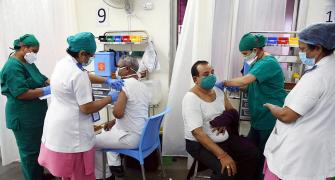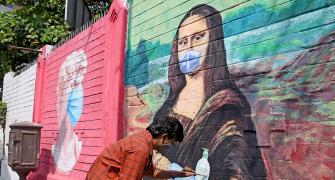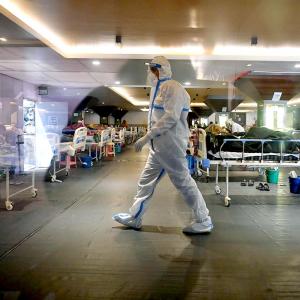'The trajectory of the disease will keep increasing because of the population density being very high.'
Rashme Sehgal reports.

The figures are alarming.
Mathematical modelling projections by leading epidemiologist Dr Girdhar Babu with the Public Health Foundation of India highlight that the states of Uttar Pradesh, Madhya Pradesh, Bihar, Chhattisgarh and West Bengal will each have more than one lakh cases per day per state in the coming days.
How has he arrived at this terrifying scenario?
Dr Babu explains, "Figures on April 16 showed there were 20,000 COVID-19 cases in UP. Each person is likely to transfer infection to at least three people in a day which means 60,000 cases. They in turn will transmit the disease to another three people per person which means 180,000 cases. The trajectory of the disease will keep increasing because of the population density being very high."
Dr Babu warns that one lakh cases per day is a conservative estimate depending on current projections. "We need to stop the trajectory of the disease and for that we need to take strong containment measures especially in states where the health infrastructure is poor," he says.
His projections are confined to 12 states and he insists that the situation could worsen across other states also if containment steps are not taken immediately.
Most of these infections are asymptomatic and do not require hospitalisation. Only five per cent will require hospitalisation and it is for these patients that we will need to enhance critical care capacities.

Given such a tsunami, one would have thought thesestates would be busy tightening their belts and putting their houses in order in order to fight the corona virus.
Far from it. Take the case of Lucknow, the capital city of India's most populous state. No emergency plan is in place. Testing for coronavirus in all private labs in the city has been stopped by the state authorities with no explanations having been provided.
The inference is that the state government does not want the actual number of cases to be out in the public domain.
A similar attempt is being made to hide the number of dead bodies being taken to the main cremation grounds in Lucknow namely Bhainsakund where the Lucknow Municipal Corporation have put up tin sheets to apparently conceal the large numbers of bodies being brought there every day for cremation.
Varanasi happens to be Prime Minister Narendra Damodardas Modi's constituency. The situation here is even worse. Long queues of dead bodies have been placed outside the ghats of Varanasi. Sometimes it takes as long as 24 hours to get a dead body cremated.
Conditions in Madhya Pradesh are even more alarming. Bodies are piling up at crematoria and burial grounds in this state reflecting a steep rise in Covid cases, but there seems to be an unexplained gap between the official daily death count released by the state government and the ground reality.
At the Bhadbhada crematorium in Bhopal, people say they have not witnessed such scenes since the 1984 Bhopal Gas Tragedy with long lines of ambulances lining up with bodies parked for hours on both sides of the road leading up to the crematorium.
On April 8, 41 bodies were cremated in Bhopal under COVID-19 protocol, but the medical bulletin reported 27 deaths in the entire state.
On April 9, 35 bodies were cremated in Bhopal, yet the official data said there were 23 Covid-related deaths in the entire state.
Hiding of crucial data has been matched by critically ill patients being turned away across hospitals in Bhopal, Indore and Ujjain because of unavailability of oxygen cylinders.
Several hospitals have taken to demanding written undertakings from attendants of patients that since there is a shortage of oxygen, the hospital will not be held responsible in case of any unpleasant incident.

Dr Ramanan Laxminarayan, director of the Center for Disease Dynamics, Economics and Policy, has also warned that India could soon be dealing with a 'tsunami' of coronavirus cases stating that if the mathematical models applied in the US or UK were applied to India, the country could be dealing with about 300 million cases, of which about four to five million could be severe.
"No country in the world, even the richest, can tackle 300 million severely ill patients," says Dr Babu.
This spread is being caused by mutations in the virus. Leading virologist Dr Shahid Jameel, director, School of Biosciences at Ashoka University. acknowledges that the "only logical explanation (for these rising cases) seems to be that the virus has changed. Variant viruses are moving much faster in the population."
"Of course that is coupled with the fact that everyone thought the virus had gone away and so (they) put their guards down. But the virus is back probably in a more infectious form. Maybe not in such a lethal form but in a more infectious form," says Dr Jameel.
Officials from India's health ministry admit as much pointing out that strains of the virus in India with 'double mutations' have been found in patients in 10 states and this could be responsible for rising infections and a faster spread in these states. These states include Maharashtra, Delhi, West Bengal, Gujarat, Karnataka and Madhya Pradesh.
A 'double mutation is when two mutated strains of a virus come together to form a third strain and this was detected after nearly 14,000 samples were subjected to genome sequencing. The one reported in India is the result of the E484Q and L452R strains combining. The L452R strain was found in California where it was found to be extremely infectious.
In Punjab and Delhi, it is the UK strain of the virus which has been dominant while in Maharashtra, patients have been found to be suffering from the double mutant strain.

Dr Monik Mehta, head of cardiology, Columbia Asia Hospital Gurgaon, believes the health ministry lost a window of opportunity between January 2021 and March 2021 to improve on health infrastructure and also beef up the entire vaccination program.
"India's pharma industry is one of the best in the world. The government had all of 2020 to allow several private players to start vaccine production in collaboration with international players. Israel has vaccinated 80 per cent of its population while the UK has vaccinated nearly 50 per cent. In the last three months, we have barely vaccinated three per cent of our population," says Dr Mehta.
"The government believed they had corona behind them forgetting that this is a mutating virus which will bounce back if social distancing and wearing of masks is not strictly implemented across the country," Dr Mehta explains.
What is even more horrifying is how health ministry officials had downplayed reports of the mutant strain right through March. The nation is paying a heavy price for this oversight.
The mutant virus has been found to be infecting all groups with the highest proportion of those getting infected belonging to the age group of between 30 to 40. Children between the age groups of 0-4 are not being spared either with deaths being reported of infants barely a few months old dying because of Covid.
This rapid rise has led to a situation where there is a shortage of everything from oxygen, drugs, and, of course, the vaccines. The shortage has seen a corresponding rise in the black marketing of drugs and oxygen cylinders.
Prices of all drugs have sky rocketed and an ambulance in Delhi is presently said to be charging a minimum of Rs 18,000 for a one hour period.
This acute shortage of oxygen cylinders has led several doctors who are in the fore front of fighting corona to insist that they are now being forced to change their line of treatment which could translate into a higher death rate.

When asked to comment on the unfolding scenario, Dr Vikram Patel, the Pershing Square professor Global Health and Social Medicine at the Harvard Medical School, says, "It is deeply distressing to witness the phenomenal gains India had made in securing control over the first wave of the epidemic being totally squandered, even though there were ample warnings from other countries that a second wave was inevitable."
"While complacency in adhering to the use of masks and physical distancing might have played a role, it seems more likely that this second wave has been greatly fuelled by a more infectious variant of the virus. If that's the case, we must all pray that the lethality of this variant is lower than the first wave and that the vaccines being rolled out will offer similar levels of protection," says Dr Patel.
Critical of the government giving the go ahead for state elections and the holding of the Kumbh Mela, Dr Patel points out, "Government policies have not helped instil confidence; for example, why do religious gatherings and political rallies escape the strictures requiring the closure of schools and markets? If anything, it should have been exactly the opposite."
"For a more hopeful perspective," adds Dr Patel, "we can at least be sure that this recurrent nightmare will end in a matter of months, thanks to the lightning spread of the infection across the population."
"Apart from the mounting toll of lost lives and sickness," he says, "I am mostly worried about the needs of the vulnerable, in particular children and adolescents who have already lost an entire year of schooling and people who are daily wagers."
"This is the time for money and compassion to be targeted to support these groups as we have witnessed in the US and many other countries," says Dr Patel. "I hope that our leaders, across the political spectrum and the community, put aside their differences and stand together, in solidarity, with the most powerless and badly affected people in our country."
Dr Babu explains how small interventions can make a huge difference. He is part of a group of doctors who are providing online video consultations to covid patients across Karnataka. "Our intervention helped reduce the death rate. Such interventions are missing in the north," says Dr Babu.
This state of collapse needs immediate remedial action. Will our political leaders intervene with corrective measures?
Feature Presentation: Ashish Narsale/Rediff.com











